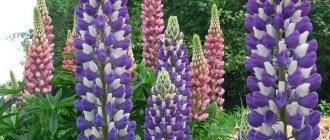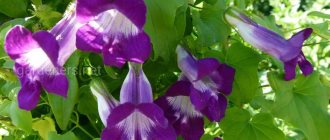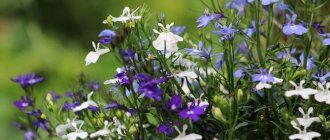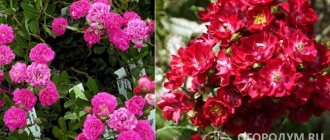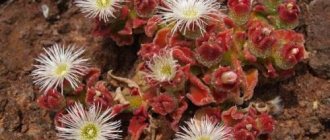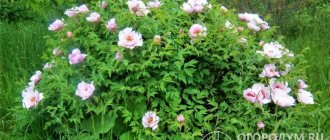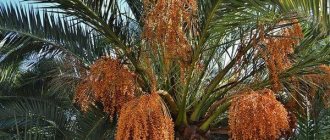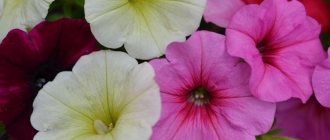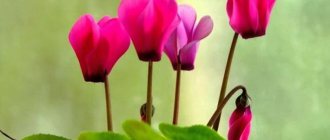Even a person who is far from floriculture and is just starting this fascinating path can grow dahlias from seeds. Today we will tell you how to properly carry out the process of growing and caring for them. Note that dahlias are among the easiest crops to plant at home, for seedlings, and then in open soil.
Dahlias from seeds: cultivation and care
Popular varieties of dahlias
Annual varieties of dahlias can be from 25 cm to one meter in height. They begin to bloom much earlier than their perennial relatives. There are a great many varieties of this flower.
Funny boys
Merry Guys
Perhaps the most famous variety is “Merry Guys”. This variety grows up to half a meter. The plant is very branchy. It blooms continuously all summer with colorful multi-colored flat flowers about 10 cm in diameter.
Cactus mixture
Cactus mixture
This variety is slightly taller than “Jolly Guys”, reaching 60 cm in height. And the edges of its petals are curled and resemble cactus needles. The flower itself is also somewhat larger, reaching 12-13 cm in diameter and double. The colors are very varied.
Figaro
Figaro Violet
This variety is a low bush, no more than 40 cm high, but very grown in width. And it is a kind of blooming ball, consisting of flowers with a diameter of 5 to 80 cm. The color of the petals is very diverse: white and yellow, orange and pink, red and burgundy.
The plant is perfect for growing in large vases and containers. Looks great in flower beds and individual colorful bushes and on a balcony or terrace.
Piccolo
Piccolo
Piccolo is very similar to “Jolly Guys”, only the bush is slightly lower and the flowers are smaller. This variety can be grown in balcony boxes and flowerpots. The plant can be formed by pinching into a neat flowering bush.
Minion
Mignon Sunshine
A very beautiful miniature variety. The height of the bush reaches only 40 cm. The plant is very branched and produces many shoots. And in July they already bear inflorescences that are quite large for such a baby, about 9 cm in diameter. The flower is simple, not double, the petals are arranged in one row. The color of the petals can be very diverse: white, red, pink, yellow.
Dahlia collared Dandy
Dandy
This variety is slightly taller than the others, about 50 cm in height. The bush looks original in a group and as a separate plant. This variety has an interesting inflorescence structure. The inner row of petals is somewhat smaller than the outer one and seems to be raised like a collar. They look simply amazing. Such flowers are good in a bouquet. The coloring is very diverse. The collar is often of a contrasting color, which looks very decorative.
Queen of the Autumn Garden
Extraordinarily beautiful flowering dahlia bushes with a varied palette of colors will delight you with long-lasting flowering until frost and will show off on the ground covered with autumn leaves. Fireworks of inflorescences of various shapes and volumes do not leave anyone indifferent to the contemplation of this beauty.
Dahlia prefers to grow in a warm and sunny place, where there is space and no wind.
The culture is unpretentious; growing dahlias will bring a minimum of hassle and a lot of pleasure. She does not like humus-rich black soil and manure as fertilizer. It will certainly delight you with its wonderful blossoming buds in the sandy loamy garden soil.
Dahlia prefers to “settle” in a permanent habitat. To decorate the garden, they are planted in flower beds, flower beds, ridges, and rocky hills. The bushes look great in single plantings and in containers. It can be combined with perennial and annual plants that will not create shading or excess density. The “Autumn Queen” loves space and freedom.
Plants of this species are perennial and annual. Planting material for perennial dahlias are tubers dug up in late autumn. Left in the ground, they simply will not survive frost and will lose their vitality. In winter, it is difficult to keep them in a healthy state - they dry out or are susceptible to diseases from dampness and inappropriate storage temperatures. For this reason, many gardeners prefer to grow many-sided beautiful flowers from seeds. Annual flowers are not inferior in variety, decorativeness and beauty to their perennial “relatives”.
Annual dahlias grow in the form of bushes. Their height ranges from 30 cm to 1 m, depending on the variety. Blooming buds also have different diameters from 6 to 14 cm. The bush should consist of no more than four shoots, otherwise the flowers will be small.
When to sow dahlias for seedlings
It takes about two to two and a half months from germination to flowering, therefore, seedlings should be planted in early April. This time is enough for strong seedlings to grow.
It is not recommended to sow seeds before April, as the seedlings will need additional lighting. This is a recommendation for the Central regions of the country, the Moscow region, the Urals and Siberia. If you live further south and it’s already warm in March, then please make allowances for your area.
How to grow dahlia seedlings at home
The seeds are quite large, so sowing them will not be difficult. You just need to prepare the appropriate container so that the plants are not crowded.
Preparing soil and containers
The soil for growing dahlia seedlings must be fertile so that it allows water and air to pass through well. An excellent solution would be a mixture consisting of garden soil, sand and humus, taken in equal quantities. The soil should be neutral or slightly acidic.
Before use, the soil must be disinfected - calcined in the oven or spilled with a solution of potassium permanganate. The container must also be treated first with boiling water and then with a pink solution of potassium permanganate.
Ampelous petunia: growing from seeds at home
Selection of seeds and preparation for sowing
Having decided on the plant variety, the seeds need to be prepared. They can be soaked for 15 minutes in a fungicide solution; a one percent manganese solution is suitable. Then soak in a growth stimulator, Epin, aloe juice with water or Zircon will do. After preparation, the seeds can be sown in the ground.
Sowing dahlias
The prepared soil is placed in prepared containers, moistened and the seeds are planted at a distance of 3 cm from each other in a checkerboard pattern. The seeds are lightly sprinkled with calcined river sand on top. This will help the sprouts hatch better and prevent blackleg disease from developing.
The plantings are covered with glass or film and placed on a heating radiator. The greenhouse is ventilated daily. In about a week or a little more, the first shoots will appear. The shelter is removed, the seedlings themselves are placed on the windowsill.
Preparing the soil mixture
You can grow dahlia seedlings in a universal substrate suitable for other flowers and vegetable crops. You can also take soil from the garden.
You can germinate dahlia seeds in calcined sand or its mixture with peat in a ratio of 1:3. This composition is not suitable for picking. For seedlings, it is better to mix peat, sand and leaf soil in proportions 1:1:2.
It is effective to add perlite to the soil mixture for seedlings. This mineral loosens the soil and improves its structure, serves as good drainage and is completely sterile.
The soil mixture for dahlia seedlings must meet a number of requirements:
- lightness and looseness;
- high water permeability;
- neutral acidity, slightly acidic reaction is allowed.
For a flower bed, it is better to choose medium-sized dahlias.
Regardless of the selected composition, the soil must be disinfected. This can be done in different ways:
- Heat in the oven. Temperature no more than 70-90 °C.
- Treat with a solution of potassium permanganate.
- Warm up for steam. To do this, place a colander in a pan, cover the bottom with gauze, and add soil.
- Freezing.
- Fungicide treatment.
To disinfect the soil for picked seedlings, it is recommended to use potassium permanganate. The solution should be dark pink and hot (up to 70 °C). Treatment is carried out 2-3 days before picking.
Seedling care
Dahlia seedlings do not require any special care. It's all about providing heat, light and watering.
Temperature and lighting
If you place the seedlings on a windowsill on the south side, then the April sun is quite enough for its needs, but the air temperature should be at least 22°C. If there is still little lighting, you need to provide the seedlings with additional light.
Watering and fertilizing
Watering for seedlings needs moderate. You shouldn’t get carried away with feeding either, but you shouldn’t ignore them either. After picking the seedlings, about a week later, you need to feed the Dahlia with fertilizer containing nitrogen and potassium. After 7-10 days, fertilizing should be repeated. Then you need to add fertilizers containing calcium and magnesium.
Important! Tall varieties of dahlias are initially fed only with nitrogenous fertilizers, and then with complex fertilizers.
Possible difficulties during cultivation
Dahlia seedlings have stretched out, what should I do?
There are 3 main reasons why dahlia seedlings could stretch:
- insufficient lighting;
- lack of nutrients;
- temperature (too warm).
What to do?
- The first thing you need to do is provide adequate lighting for your dahlias. Read more about lighting for seedlings in this article.
- Reduce the growing temperature to 18-20 degrees.
- Elongated seedlings often have an acute deficiency of phosphorus, magnesium and boron. Therefore, it is worth removing nitrogen fertilizers for a while and feeding them several times with an extract of superphosphate with the addition of potassium magnesium.
Fertilizer for stretched seedlings
- Prepare superphosphate extract: 1 tsp. dilute superphosphate in 100 ml of boiling water
- Add water to the resulting solution to 2 liters
- Add 1 tsp. potassium magnesia. The fertilizer is ready!
Picking
When 2-3 leaves are formed, approximately two weeks after germination, the seedlings must be pruned. Otherwise, the seedlings will stretch upward, the root system will develop poorly and you won’t get a beautiful, strong bush.
It is best to pick seedlings in separate small containers, about 12 cm high, but you can also put them in a box of the same height, but the distance between plants needs to be 5-7 cm. After the dahlias have been picked, they need to be put in the shade for a couple of days with a lower temperature. This way the stress you will experience will be less.
When to plant marigold seedlings
How to pick dahlia seedlings - video
Problems after landing or transplantation
Dahlias may wither, bloom poorly or not bloom at all for several reasons:
- Planted in the shade, the stems are stretched, the bushes do not have enough strength to flower.
- The roots are flooded with excessive watering or rain, they rot, and behind them the bush dies.
- It’s hot, there’s no watering, the bushes are drying out.
- The extra shoots and stems were not removed, thickets grew from the tops, which absorb a lot of nutrition from the ground, and there is no longer enough energy or time for flowering.
- The bushes have been overfed with nitrogen fertilizers; there is food for the stems and leaves, but not for flowering.
- Diseases and pests have attacked, the juices are pumped out, and the plants are not treated.
- There weren’t enough warm days: the variety was late, and germination and planting were delayed.
These problems will not arise if you follow the planting and care rules already stated above. As for the lack of flowering, it is usually expected until the end of summer - autumn, when it is too late to do anything. Identify your mistakes and don’t make them in the future, then you will be able to grow real beauty.
Dahlias are demanding already at the planting stage. But this makes them even dearer and dearer to the heart. If everything is done correctly, the bushes will bloom for a long time and beautifully, to the envy of all the neighbors and to your delight.
Planting dahlia seedlings in open ground
When the threat of return frosts has passed, dahlias can be planted in a permanent location.
It should be taken into account that these flowers prefer loose, slightly acidic soil.
A prerequisite for the soil is good drainage so that there is no stagnation of moisture. The place should be sunny. They, of course, can tolerate shade, but the flowering will be weak, and the elongated bush will be unattractive. So it is better not to plant dahlias near trees, buildings and lush shrubs.
- Holes are made in the prepared bed so that the root of the plant can freely fit.
- Add a handful of ash and a little humus to each hole, moisten and plant dahlias.
- In order not to injure the root when removing it from the container, the seedlings must be thoroughly watered and allowed to soak in the soil, so the plant can be easily removed. If peat pots were used, then seedlings are planted along with the pots. The plant should be buried down to the first cotyledon leaves.
- The distance between holes should be from 30 to 50 cm for short and compact species. For tall varieties, the distance between holes should be increased to 80 cm.
Important! The soil around the plant must be mulched. This will protect you from weeds and fungal diseases. It will also serve as additional warmth for the roots.
After the seedlings are planted in open ground, they must be shaded for better rooting. After 3-4 days, the cover is removed.
How to plant lobelia seedlings correctly
Diseases and pests
The most common diseases that affect dahlias are:
- Botris, Gray Rot;
- White rot;
- Fusarium.
Botrytis, or gray rot - brown spots appear on the leaves, then the leaves gradually dry out and fall off. All parts of the plant are affected, the buds do not open, and the plant dries out. The reason for the development of this disease is high humidity, so most often it occurs in spring or autumn when the weather changes. Deep necrosis forms on the tubers; such tubers rot during storage
By the appearance of brown spots on the leaves, which subsequently dry out and fall off. As the disease grows, it affects large areas of the plant, and it is determined that the dahlia is affected by rot. Fusarium develops in the root system. These diseases cannot be treated. Sick individuals should be disposed of to prevent the disease from spreading further. For prevention purposes, you need to select the right soil, without stagnant water. You also need to be careful with watering, not to overdo it.
Among the pests that annual dahlias can choose:
- Aphid;
- Slugs;
- Bedbugs.
If uninvited guests are detected, the plant should be treated with insecticides. With slugs, they provide an effective method: sawdust, scattered between the plants, will injure the delicate body of the slugs, and they will leave the garden bed.
How to collect your seeds
Seeds of annual dahlias can be bought at a flower shop, or you can prepare them yourself. To do this, mark the flower you like with a thin thread or in some other way and allow it to fully ripen. That is, after withering it is not removed. In place of the faded flower, a light green box is formed in which the seeds ripen. After ripening, the box takes on a dark beige color. Ripe seeds may spill out of the capsule. To prevent this from happening, you can do two things:
- The stems of the plant are cut and brought into a warm, well-ventilated room. Tie heads down.
- The box that begins to change color is tied with a piece of gauze. The seeds will ripen naturally, but will not fall off.
It is best to harvest seeds from the first flowers. This way you are more likely to get fully ripened seeds. If in the fall, and this is precisely the time when the seed pods ripen, there is a lot of precipitation, then it is better to let the seeds ripen at home at a temperature of 20-25 degrees above zero. Dahlia seeds can be collected several years in advance; they remain viable for 3-4 years. It is best to store Seeds in paper bags or linen bags in a dry place.
